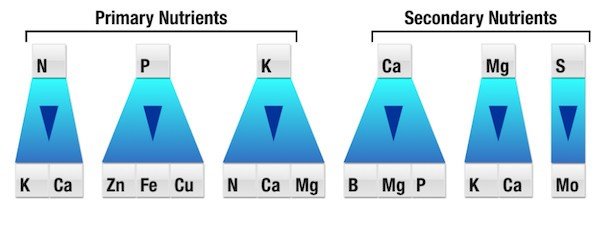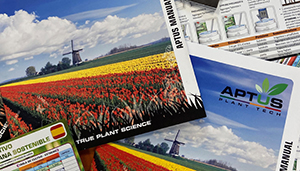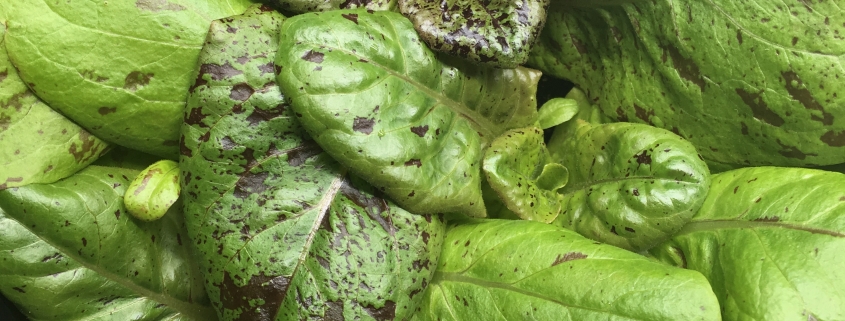Nutrient Interactions & Antagonism
It is very important to understand how certain nutrients react with each other. If you don’t understand these interactions, you may over-supplement with a specific nutrient in an attempt to correct a deficiency.
Not all deficiencies are caused by a lack of nutrients! For example, calcium deficiency may be diagnosed due to low calcium levels OR because there are high levels of nitrates (NO3). Nitrates ‘push’ calcium away and can block absorption.
That’s why it’s better to use organic nitrogen instead of inorganic nitrogen, which is high in nitrates. Many modern synthetic fertilizers primarily contain nitrates or other salt-based forms of nitrogen. The salts are the most common cause of tip burn, nutrient antagonism, and weak plant growth.


The antagonistic action of nutrients shows how overdoses of certain elements can lockout or displace another element. This list shows which elements react with each other. Understanding nutrient antagonism makes diagnosing deficiencies and excesses more difficult, but ultimately more accurate.
Most nutrients usually work together, but this is not always the case. If there’s excess phosphorus it increases the plant’s nitrogen uptake, unbalancing the nutrition. At the same time, it also limits the uptake of zinc, iron, and copper. Optimum nutrition is achieved by balancing the nutrients in the medium.
These problems often arise when growers attempt to create their own ‘custom’ nutrient recipe, mixing different product lines from different companies. Unless a grower has a serious scientific bent, this practice often results in overdose and deficiency of specific nutrients.
The plants get into wild swings of deficiencies and lockout which results in decreased yield and quality. By using a balanced, high-quality, specifically formulated nutrition system, plants can maximize their genetic potential.
WHY MODERN PLANT NUTRITION CREATES ANTAGONISM
Perhaps you’ve noticed that each of these core concepts touches on all the others. Plants are systems—intricate, delicate, and intertwined systems of biochemical reactions happening constantly within and around the plant.
Modern plant nutrition often called ‘NPK agriculture’, is based on the idea that if we add the major nutrients needed, plants will grow. Nature will always find a way to survive despite mistakes we may make, but that doesn’t mean that our plants are at optimal health.
NPK agriculture has shown us that this simplistic approach is not effective. Our crops are less nutritious, more susceptible to pests and disease, our soils are dead and infertile, and crop yields are decreasing around the world.
Perhaps the most important concept that can begin to fix this issue is the principle of nutrient antagonism. In a growing medium, nutrient molecules are constantly pushing and pulling at each other based on form and electrical charge. This ‘dance’ is fundamentally important to how well plants are able to take up and assimilate nutrients.
NPK agriculture doesn’t do a very good job of considering the balance of soil mineral contents and fertilizer inputs. Properly structured soil and balanced fertilizer programs help to balance the activity of nutrients and simulate natural environments.
Consider a virgin rainforest. The vastness and density of the vegetation are mind-boggling. The fruits and flowers are massive and incredibly flavorful. It’s also the most nutritious food found anywhere on earth. How this is possible without human interaction you wonder? It’s because nature has found ways to balance nutrients through microbial activity, natural soil remediation, and biological systems.
It’s impossible to fully replicate these intricate systems in isolated indoor (and many outdoor) environments. But we can learn from the biological rules and see many of the same benefits.
P/K BOOSTERS
Many growers supplement with phosphorus and potassium boosters at various stages of flowering to increase the weight and yield of their crops. It’s true that these primary nutrients are essential for plant growth, especially in fruit development and maturation. If we want to maximize our yields and quality of the harvest, most situations require phosphorus and potassium supplementation.
As with other nutrients, phosphorus can easily become locked up in the soil by combining with other minerals, and potassium tends to wash away fairly readily from the growing area. So both are needed in higher quantities and at the right time for the plant to use.
Indoor gardeners often provide both phosphorus (P) and potassium (K) at the same time in large doses in an effort to boost yields, but this can come at a cost. In the early stages of flower and fruit development, a plant needs more phosphorus and less potassium. So if a grower adds a lot of potassium in the early stages, it remains unused in the medium. That doesn’t mean it’s inactive. In fact, the potassium begins to interact and antagonize other key nutrients (calcium, magnesium, nitrogen). This is the most common reason why growers experience calcium and magnesium deficiencies in early bloom stages.
The same grower may continue to use the P/K booster later in bloom when the plant needs far less phosphorus and more potassium. So the phosphorus remains unused in the medium, but again, not inactive. Unused phosphorus is notorious for binding with other minerals, making them unavailable (such as calcium and several micro-elements). The point we’re trying to make is that in order to optimize plant growth and production we need to work as a military sniper, providing nutrition as close to the point of need. This is how nature prefers and this is how we reach our goals.
FINAL THOUGHTS ON NUTRIENT INTERACTION
Most growers focus on their feed water mix. Sometimes they are very scientific about what products they use, and how they apply their fertilizer. And this is good. What goes in affects what comes out.
But there is a deeper and more important consideration. We’ve got to start looking more closely at the growing medium and the root zone. This is where the magic happens. This is where we achieve success or experience failure.
There is a common saying amongst organic farmers, “Feed the soil, not the plants.” The plant is only part of the equation. There are extremely complex and somewhat mysterious activities occurring constantly between mineral ions, microbes, plant tissue, water, and gases.
Ultimately every situation, every plant, every medium, every growing environment is slightly different. To achieve the greatest results consistently, growers need to become intimately aware of the specific demands of their garden. Without this understanding, it’s easy to cause unseen problems that have drastic, negative effects.





